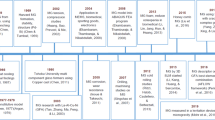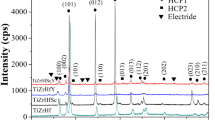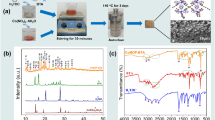Abstract
The glass-forming Ti75Zr10Si15 and Ti60Zr10Nb15Si15 alloys composed of nontoxic elements may represent new materials for biomedical applications. For this study, melt-spun alloy samples exhibiting glass-matrix nanocomposite structures were subjected to thermal oxidation treatments in synthetic air to improve their surface characteristics. 550 °C was identified as the most appropriate temperature to carry out oxidative surface modifications while preserving the initial metastable microstructure. The modified surfaces were evaluated considering morphological and structural aspects, and it was found that the oxide films formed at 550 °C are amorphous and consist mainly of TiO2; their thicknesses were estimated to be ∼560 nm for Ti75Zr10Si15 and ∼460 nm for Ti60Zr10Nb15Si15. The thermally treated sample surfaces exhibit not only higher roughnesses and higher hardnesses but also improved wettability compared to the as-spun materials. By immersion of oxidized samples in simulated body fluid Ca- and P-containing coatings exhibiting typical morphologies of apatite are formed.








Similar content being viewed by others
References
C. Suryanarayana and A. Inoue: Bulk metallic glasses (CRC Press, Boca Raton, 2011).
J.-J. Oak, D.V. Louzguine-Luzgin, and A. Inoue: Investigation of glass-forming ability, deformation and corrosion behavior of Ni-free Ti-based BMG alloys designed for application as dental implants. Mater. Sci. Eng., C 29, 322 (2009).
J.J. Oak, D.V. Louzguine-Luzgin, and A. Inoue: Fabrication of Ni-free Ti-based bulk-metallic glassy alloy having potential for application as biomaterial, and investigation of its mechanical properties, corrosion, and crystallization behavior. J. Mater. Res. 22, 1346 (2007).
F. Qin, X. Wang, S. Zhu, A. Kawashima, K. Asami, A. Inoue: Fabrication, and corrosion property of novel Ti-based bulk glassy alloys without Ni. Mater. Trans. 48, 515 (2007).
M. Calin, A. Gebert, A.C. Ghinea, P.F. Gostin, S. Abdi, C. Mickel, and J. Eckert: Designing biocompatible Ti-based metallic glasses for implant applications. Mater. Sci. Eng., C 33, 875 (2013).
S. Abdi, S. Oswald, P.F. Gostin, A. Helth, J. Sort, M.D. Baró, M. Calin, L. Schultz, J. Eckert, and A. Gebert: Designing new biocompatible glass-forming Ti75−xZr10NbxSi15 (x = 0, 15) alloys: Corrosion, passivity, and apatite formation. J. Biomed. Mater. Res., Part B 104B, 27–38 (2015).
S. Abdi, M.S. Khoshkhoo, O. Shuleshova, M. Bönisch, M. Calin, L. Schultz, J. Eckert, M.D. Baró, J. Sort, and A. Gebert: Effect of Nb addition on microstructure evolution and nanomechanical properties of a glass-forming Ti–Zr–Si alloy. Intermetallics 46, 156 (2014).
F. Variola, F. Vetrone, L. Richert, P. Jedrzejowski, J.H. Yi, S. Zalzal, S. Clair, A. Sarkissian, D.F. Perepichka, J.D. Wuest, F. Rosei, and A. Nanci: Improving Biocompatibility of implantable metals by Nanoscale modification of Surfaces: An Overview of Strategies, fabrication methods, and Challenges. Small 5, 996 (2009).
X. Liu, P.K. Chu, and C. Ding: Surface modification of titanium, titanium alloys, and related materials for biomedical applications. Mater. Sci. Eng., R 47, 49 (2004).
S. Kumar, T.S.N. Sankara Narayanan, S. Ganesh Sundara Raman, and S.K. Seshadri: Thermal oxidation of Ti6Al4V alloy: Microstructural and electrochemical characterization. Mater. Chem. Phys. 119, 337 (2010).
M. Long and H.J. Rack: Titanium alloys in total joint replacement—a materials science perspective. Biomaterials 19, 1621 (1998).
P.A. Dearnley: A review of metallic, ceramic and surface-treated metals used for bearing surfaces in human joint replacements. Proc. Inst. Mech. Eng., Part H 213, 107 (1999).
S. Minagar, C.C. Berndt, J. Wang, E. Ivanova, and C. Wen: A review of the application of anodization for the fabrication of nanotubes on metal implant surfaces. Acta Biomater. 8, 2875 (2012).
T. Hanawa: Research and development of metals for medical devices based on clinical needs. Sci. Technol. Adv. Mater. 13, 064102 (2012).
S. Kumar, T. Narayanan, S.G.S. Raman, and S.K. Seshadri: Thermal oxidation of CP-Ti: Evaluation of characteristics and corrosion resistance as a function of treatment time. Mater. Sci. Eng., C 29, 1942 (2009).
M.C. Garcia-Alonso, L. Saldana, G. Valles, J.L. Gonzalez-Carrasco, J. Gonzalez-Cabrero, M.E. Martinez, E. Gil-Garay, and L. Munuera: In vitro corrosion behaviour and osteoblast response of thermally oxidised Ti6Al4V alloy. Biomaterials 24, 19 (2003).
S. Kumar, T. Narayanan, S.G.S. Raman, and S.K. Seshadri: Thermal oxidation of CP Ti—An electrochemical and structural characterization. Mater. Charact. 61, 589 (2010).
S. Kumar, T.S.N.S. Narayanan, and S. Ganesh Sundara Raman, and S.K. Seshadri: Surface modification of CP-Ti to improve the fretting-corrosion resistance: Thermal oxidation vs. anodizing. Mater. Sci. Eng., C 30, 921 (2010).
M.F. Lopez, J.A. Jimenez, and A. Gutierrez: Corrosion study of surface-modified vanadium-free titanium alloys. Electrochim. Acta 48, 1395 (2003).
H. Ahn, D. Lee, K.-M. Lee, K. Lee, D. Baek, and S.-W. Park: Oxidation behavior and corrosion resistance of Ti–10Ta–10Nb alloy. Surf. Coat. Technol. 202, 5784 (2008).
S.B. Patel, A. Hamlekhan, D. Royhman, A. Butt, J. Yuan, T. Shokuhfar, C. Sukotjo, M.T. Mathew, G. Jursich, and C.G. Takoudis: Enhancing surface characteristics of Ti–6Al–4V for bio-implants using integrated anodization and thermal oxidation. J. Mater. Chem. B 2, 3597 (2014).
V. Sollazzo, F. Pezzetti, A. Scarano, A. Piattelli, L. Massari, G. Brunelli, and F. Carinci: Anatase coating improves implant osseointegration in vivo. J. Craniofac. Surg. 18, 806 (2007).
J. Forsgren, S. Svahn, T. Jarmar, and H. Engqvist: Formation and adhesion of biomimetic hydroxyapatite deposited on titantium substrates. Acta Biomater. 3, 980 (2007).
S. Oswald, P.-F. Gostin, A. Helth, S. Abdi, L. Giebeler, H. Wendrock, M. Calin, J. Eckert, and A. Gebert: Xps and AES sputter-depth profiling at surfaces of biocompatible passivated Ti-based alloys: Concentration quantification considering chemical effects. Surf. Interface Anal. 46, 683 (2014).
T. Kokubo and H. Takadama: How useful is SBF in predicting in vivo bone bioactivity?. Biomaterials 27, 2907 (2006).
J.D. Cox, D.D. Wagman, and V.A. Medvedev, eds.: Key values for thermodynamics (Hemisphere Publishing Co., New York, 1989).
M. Metikos-Huković, A. Kwokal, and J. Piljac: The influence of niobium and vanadium on passivity of titanium-based implants in physiological solution. Biomaterials 24, 3765 (2003).
P. Gabbott, ed.: Principles and applications of thermal analysis (Blackwell Publishing Ltd., Oxford, 2008).
B.E. Deal and A.S. Grove: General relationship for the thermal oxidation of silicon. J. Appl. Phys. 36, 3770 (1965).
P. Perez, V.A.C. Haanappel, and M.F. Stroosnijder: The effect of niobium on the oxidation behaviour of titanium in N2/20% O2 atmospheres. Mater. Sci. Eng., A 284, 126 (2000).
T.K. Roy, R. Balasubramaniam, and A. Ghosh: High-temperature oxidation of Ti3Al-based titanium aluminides in oxygen. Metall. Mater. Trans. A 27, 3993 (1996).
M.N. Armenise, C. Canali, M. DeSario, A. Carnera, P. Mazzoldi, and G. Celotti: Characterization of TiO2, LiNb3O8, and (Ti0.65Nb0.35)O2 compound growth observed during Ti:LiNbO3 optical waveguide fabrication. J. Appl. Phys. 54, 6223 (1983).
J. Nychka and M. Gentleman: Implications of wettability in biological materials science. JOM 62, 39 (2010).
P.F. Gostin, A. Helth, A. Voss, R. Sueptitz, M. Calin, J. Eckert, and A. Gebert: Surface treatment, corrosion behavior, and apatite-forming ability of Ti–45Nb implant alloy. J. Biomed. Mater. Res., Part B 101B, 269 (2013).
ACKNOWLEDGMENTS
The authors thank S. Donath for sample preparation, C. Geringswald for thermogravimetric experiments, B. Bartusch for DSC measurements, A. Voβ for SBF testing and S. Kaschube for AES measurements. Funding by the European Commission within the framework of the FP7-MCITN network BioTiNet (PITN-GA-2010-264635) is gratefully acknowledged.
Author information
Authors and Affiliations
Corresponding author
Additional information
This author was an editor of this journal during the review and decision stage. For the JMR policy on review and publication of manuscripts authored by editors, please refer to http://www.mrs.org/jmr-editor-manuscripts/.
A previous error in this article has been corrected, see https://doi.org/10.1557/jmr.2016.192.
Rights and permissions
About this article
Cite this article
Abdi, S., Bönisch, M., Oswald, S. et al. Thermal oxidation behavior of glass-forming Ti-Zr-(Nb)-Si alloys. Journal of Materials Research 31, 1264–1274 (2016). https://doi.org/10.1557/jmr.2016.122
Received:
Accepted:
Published:
Issue Date:
DOI: https://doi.org/10.1557/jmr.2016.122




